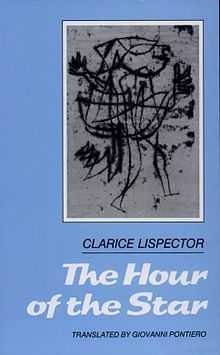The Hour of the Star
 Cover of the English edition | |
| Author | Clarice Lispector |
|---|---|
| Original title | A hora da estrela |
| Translator | Giovanni Pontiero |
| Country | Brazil |
| Language | Portuguese |
| Genre | Novel |
| Publisher | José Olympio Editora |
Publication date | 1977 |
Published in English | 2011 |
| Media type | Print (Paperback) |
| ISBN | 978-0-8112-1949-5 |
| OCLC | 24246408 |
| 869.3 20 | |
| LC Class | PQ9697.L585 H6713 1992 |
| Preceded by | Onde estivestes de noite (Where Were You At Night) |
| Followed by | Um sopro de vida (pulsações) (A Breath of Life (pulsations)) |
The Hour of the Star (A hora da estrela) is a novel by Clarice Lispector published in 1977, shortly after the author's death. In 1985, the novel was adapted by Suzana Amaral into a film of the same name, which won the Silver Bear for Best Actress in the 36th Berlin International Film Festival of 1986.[1] It has been translated into English twice by New Directions Publishing with Giovanni Pontiero's 1992 translation followed by Benjamin Moser's version in 2011.[2]
Plot summary
Narrated by the cosmopolitan Rodrigo S.M., this brief, strange, and haunting tale is the story of Macabéa, one of life's unfortunates. Living in the slums of Rio and eking out a poor living as a typist, Macabéa loves movies, Coca-Cola, and her rat of a boyfriend; she would like to be like Marilyn Monroe, but she is ugly, underfed, sickly, and unloved. Rodrigo recoils from her wretchedness, and yet he cannot avoid the realization that for all her outward misery, Macabéa is inwardly free. She doesn't seem to understand how unhappy she should be.
Lispector employs her pathetic heroine against her urbane, empty narrator - edge of despair to edge of despair - and, working them like a pair of scissors, she cuts away the reader's preconceived notions about poverty, identity, love, and the art of fiction, taking readers close to the true mystery of life.
Themes
The Hour of the Star deals with the problems of the rural Northeast versus the urban Southeast, poverty and the dream of a better life, and, of an uneducated woman’s struggle to survive in a sexist society.[3] In February 1977, Lispector gave her only televised interview, with Júlio Lerner of TV Cultura in São Paulo. In it, she mentioned a book she had just completed with “thirteen names, thirteen titles,” though she refused to name them. According to her, the book is "the story of a girl who was so poor that all she ate was hot dogs. That’s not the story, though. The story is about a crushed innocence, about an anonymous misery."[4][5]
Background and publication
Clarice used her own childhood in the Northeast region of Brazil as reference to build the protagonist Macabéa. She also mentioned a gathering of people from this region in the São Cristóvão neighborhood of Rio de Janeiro, where she first captured the "disoriented look" of the Northeasterns in the city.[4] Clarice was also inspired by a fortune teller she visited, an event upon which she bases the final part of the plot. When she was leaving the fortune teller's house, she found it amusing to imagine herself being hit by a yellow Mercedes and dying immediately after hearing all the good projections the fortune teller foresaw for her future.[4]
The novel was composed from short fragments that Lispector and her secretary, Olga Borelli, pieced together.[6] Lispector was not aware that she was dying at the time she wrote it, though the work is full of premonitions of her upcoming death.
Reception
Peter Bricklebank in his review for Library Journal described the novel as "both introspection and fiction" and that it was a "compassionate meditation with a fine afterward, this slim volume will attract lovers of philosophical fiction".[7] Barbara Mujica in her review for Americas described the novel as "the last and perhaps greatest novel of the Brazilian writer Clarice Lispector" and that "The Hour of the Star is also a meditation on writing. Through Rodrigo, Lispector brings into question the notion of authorial supremacy. Rodrigo is not the omnipotent, invisible creator, but a thinker who doubts, vacillates, and questions his own work. In The Hour of the Star and other novels, Lispector throws into doubt the ability of fiction to capture the truth."[8]
Notes
- ↑ "Berlinale: 1986 Prize Winners". berlinale.de. Retrieved 2011-01-14.
- ↑ Benjamin Moser (Translator), Colm Tóibín (Introduction). The Hour of the Star (Second Edition), New Directions; Second Edition (November 9, 2011). ISBN 978-0-8112-1949-5
- ↑ Magill, Frank Northen; Rollyson, Carl E. (2000). Critical survey of long fiction. Pasadena, Calif: Salem Press. ISBN 0-89356-882-1.
- ↑ 4.0 4.1 4.2 Lerner, Júlio. Interview with Clarice Lispector, produced by TV Cultura, filmed in February 1977, first aired in December 1977.
- ↑ This interview is widely available on the Internet, from YouTube and other sources.
- ↑ Cadernos de Literatura Brasileira : Clarice Lispector. Rio de Janeiro: Instituto Moreira Salles. 2004.
- ↑ Bricklebank, Peter (April 15, 1986). "The Hour of the Star (Book)". Library Journal 111 (7): 96. ISSN 0363-0277.
- ↑ Mujica, Barbara (1992). Americas 44 (1): 61. ISSN 0379-0940. Missing or empty
|title=(help)